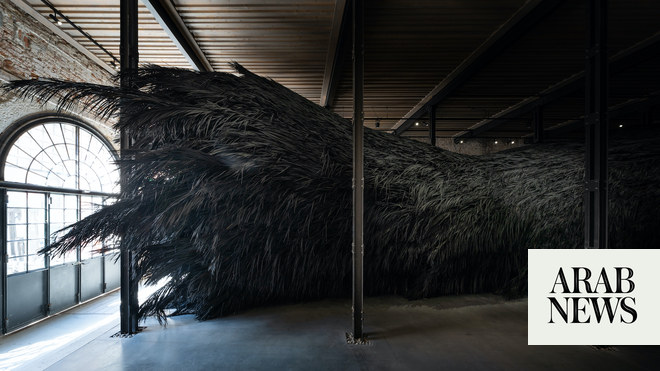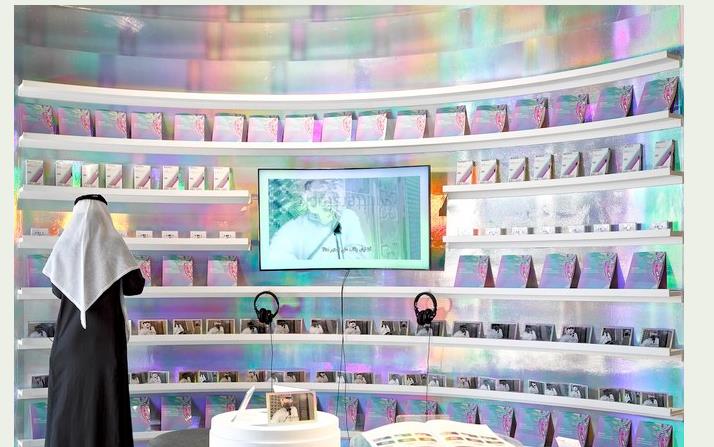
‘The making of the work is the adventure,’ says Muhannad Shono
DUBAI: Saudi artist Muhannad Shono’s conceptual installations have been garnering praise both regionally and globally in recent years. Not that Shono himself takes much notice.
For the latest updates, follow us on Instagram @arabnews.lifestyle
“People’s reaction to my work — whether they like it or not — is the not the well I drink from,” he tells Arab News. “It’s not what’s pushing me. I can see the impact, but I don’t do it for the impact. . . It becomes a life that you can no longer speak for, defend, or nurture. You put it out there and it needs to find its own way.”
His projects have been displayed in regional and international biennales and festivals, and have tackled thought-provoking themes including personal loss, defining childhood memories, and the rigidity of language.
Shono works with a variety of tactile raw materials, from sand to pipes, setting up installations in the unlikeliest of places, including an old administrative building and the open desert. “The making of the work is the adventure,” he says.
His color scheme is notably monochromatic, focusing on blacks, whites, and greys. “I was never attracted to color,” he says. He developed an obsession with black, mostly due to the thick black lines that censored pages of the comic books he read consistently as an imaginative child who liked telling stories and making up characters.
A milestone in the career of Shono, who was born and raised in Saudi to Syrian parents, was representing Saudi Arabia at the Venice Biennale in 2022, where he presented a self-described “undeniable object” called “The Teaching Tree,” filling up the entire length of the pavilion.
“For me to represent the country and be in this position where I’m being recognized as a Saudi is very indicative of a wider acceptance of what it means to be Saudi, and a new shift to a wider embrace that I didn’t feel so much in the first chapter of my time here,” he says.
Here, Shono walks us through some of his most significant projects from the past four years.
‘The Teaching Tree’ (2022)
“The Teaching Tree” is an act of creative resistance. It’s an embodiment of the living imagination, though there were attempts to silence the creative spirit. It is a tree that duplicates, multiplies, and grows from a single line and becomes a teaching tree. It’s taking teachings that we’re trying to limit the imagination and from it begets monsters to defend the imagination. It’s a tricky thing to use the palm material because it’s such an overused symbol, but I think it worked out well. It created a new skin. Of course, the whole thing is breathing, powered by nematics. It was at the Saudi pavilion at the Venice Biennale. There were a lot of tears on the day of the inauguration. (Laughs.)
‘I See You Brightest in the Dark’ (2023)
This work is about loss. It was displayed in Noor Riyadh festival in an administrative building that I rented out. It begins in the basement, welcoming in visitation of light. It’s very sculptural — there are threads of white light in a darkened room. Then you go up to the ‘Library of Memories.’ We collect the memories and spool them. There are around 300 spools — or ‘books’ — that go up to a loom, where we try to weave (the memories) back into tangibility, which is futile. It all flows up to the roof, where we let go. We have this fresh sheet and this moment of acceptance and a new sky above us.
‘On Losing Meaning’ (2021)
“On Losing Meaning” is a sculptural robot. Or a word made out of pigment that has lost its meaning. It doesn’t know what its definition is, so it’s searching for its meaning. It’s a metallic skeleton coated with petroleum jelly, black carbon, and beeswax. The irony is that the more it searches through performative mark-making, trying to find itself, the more it destroys its figurative shape, thus losing its meaning. It eventually breaks down and erodes. You’ll see that in a few of these projects, there is a rejection of the rigidity of language, definition and meaning in the doctrinal sense.
‘The Silence Is Still Talking’ (2019)
This work was from a show addressing the labor needed to reform, reshape, and rehabilitate our relationship with the rigid word that is intolerant and hard to negotiate with. By using only charcoal, the work was about breaking down a word or a sentence that had a definition and form and we ground it down until it lost its legibility. It lost its power. We took this pigment, which was now a raw material, and we used it throughout this show, trying to excavate new words and new definitions that are more fluid.
‘On This Sacred Day’ (2022)
This work is in an oasis in AlUla. It addresses the local people in AlUla who were afraid of the change that was coming, and what that meant for their jobs, families, and homes. There were anecdotes of people being frustrated about the change. I came across palm trees that were burned down, due to pests and diseases. I created these black sculptural objects as a way of processing that change and to address the idea of controlled burns versus wildfires.
‘The Lost Path’ (2020)
“The Lost Path” was 300 meters long with 60,000 pipes. It was in the inaugural Desert X in AlUla. I created a sculptural path that was not visible from the main site, but if you followed it, as the hero, you were gifted not with a treasure chest (which is often empty at the end of these kinds of adventures), but with a very quiet, secluded moment at the end of “The Lost Path,” where there is no signal or sound you can hear. So I gift to you a moment with yourself. A friend and I developed the structure and then we had eight (people helping). We killed ourselves to make this happen. I wouldn’t be able to redo it, because I know too much about what it takes.











